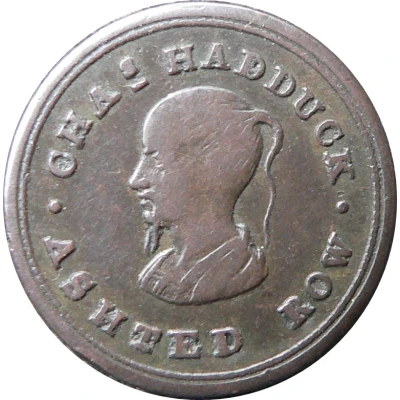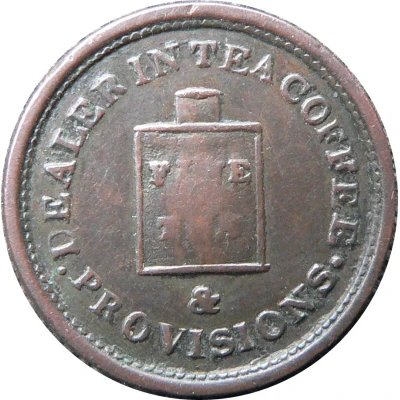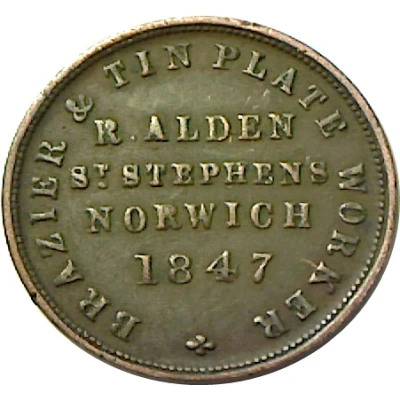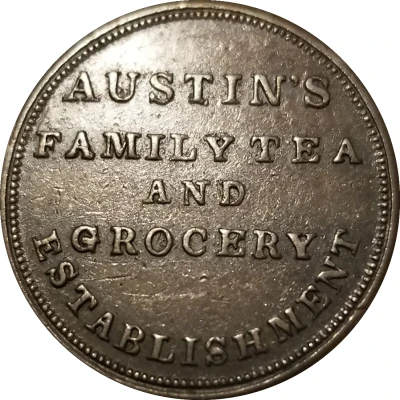
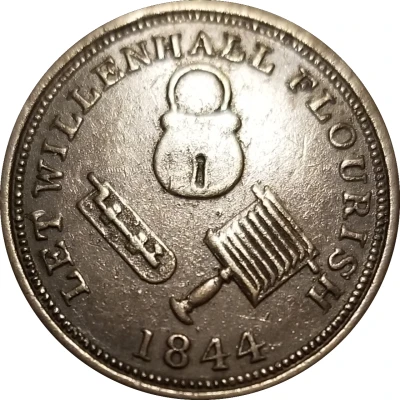

© Disha41754 (CC BY)
1 Farthing Staffordshire - Willenhall
1844 year| Copper | - | 21 mm |
| Location | United Kingdom (United Kingdom, British Overseas Territories and Crown Dependencies) |
|---|---|
| Type | Medals › Advertising medallions |
| Year | 1844 |
| Value | ¼ Penny (1⁄960) |
| Composition | Copper |
| Diameter | 21 mm |
| Thickness | 1 mm |
| Shape | Round |
| Technique | Milled |
| Orientation | Medal alignment ↑↑ |
| Updated | 2024-11-14 |
| Numista | N#89658 |
|---|---|
| Rarity index | 87% |
Reverse
A padlock, door bolt, and curry-comb in centre with lettering around and date below. Beaded border
Script: Latin
Lettering:
LET WILLENHALL FLOURISH
1844
Edge
Plain
Comment
John Austin Willenhall Farthing 1844.John Austin was a tea dealer and grocer in Stafford Street, Willenhall which is famous for the manufacture of padlocks and related items.
In 1844 in Willenhall the miller John Austin issued tokens worth one farthing (a quarter of an old penny; there were 960 farthings in a pound so each was worth about one tenth of a present day penny). These farthings were used to give change in the shop or to pay employees so that they could spend the money in the Austin shop or, apparently, elsewhere. There was a shortage of coinage at the time and the issue of tokens was fairly commonplace.
One side has "Austin's Family Tea and Grocery Establishment" and the other has the resounding slogan "Let Willenhall Flourish" with a lock, a bolt, and a curry-comb - Willenhall's main products.
In 1862 these tokens were declared illegal and new bronze coinage was issued.
Catalogues: Unofficial Farthing Bell No. Staffordshire 47
From The British Museum:
https://www.britishmuseum.org/research/search_the_collection_database/term_details.aspx?bioId=71985
John Austin (merchant/tradesman; English; Male; 1842 - 1861; active)
Willenhall, West Midlands
(formerly Staffordshire)
Miller, baker and grocer later artificial manure manufacturer. Issued tokens.
According to Withers 2013 catalogue entry at the 1851 census he is listed as being aged forty one, employing thirteen men and having been born in Longdon on Tern, Shropshire. His wife Ann was thirty seven. They lived in Stafford Street and had one son aged four. Two domestic servants, one assistant grocer and four apprentice bakers lived in. By the 1861 census they had moved to Wrockwardine, where he was a manure manufacturer employing sixteen men and boys. His son, aged fourteen, his mother, aged eight one, and one general servant where living with them. At the 1881 census he was a widower aged seventy one, living at Allscoot, Wrockwardine, where he was an agricultural chemist employing twenty. His son, aged thirty four, was working in the business. His son and daughter-in-law, who were living with him, had three children. Also living with him were his widowed sister, his niece was housekeeper, and they had two domestic servants. In 1891, now aged eighty one, he was still living at Wrockwardine and still a manufacturer of chemical manure. His son, now forty four, was working in the business, and he and his wife now had just one child, aged thirteen, still left at home. There were three servants living in.
According to the same source in 1853 Austin sold his business to Joshua Rushbrooke, who had previously worked at Birchills Mill in Walsall. 'The Annals of Willenhall' by Frederick William Hackwood, Wolverhampton, 1908, is interesting. Chapter XXXVI contains the following:
"John Austin, the tradesman, who first issued the 'Willenhall farthings' mentioned in Chapter XXVII, was an enterprising tradesman, a man of handsome presence and an alert mind. On leaving Willenhall he went to live at Manor House, Allscott, near Wellington, at which town he established artificial manure works, and where he manufactured sulphuric acis very extensively.
The issue of the Willenhall trade farthings was continued by Rushbrooke, his successor in the business (1853), through the original date, "1844" was always retained by them. They were sold to shopkeepers and traders, all round the district at the of 5s. nominal for 4s. 9d. cash. When the new national bronze coinage came into circulation in 1860, large quantities of these copper farthing token were returned on to Mr Rushbrooke's hands, but he melted them down without sustaining the least loss."
